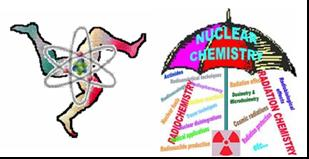Speaker
Mr
Naoyuki OSADA
(Graduate school of Engineering, Kyoto University)
Description
High-energy proton accelerator produces radiation which induces radiation-chemical reactions of the air in accelerator rooms. The radiolytic product, such as nitrogen oxide, in the accelerator room air forms a huge amount of aerosol particles. In this work, an air chamber was bombarded with a 50-MeV proton beam, and the number concentration and the size distribution of the particles formed in the chamber were measured. Irradiated air was aerosol-free pure air (N2 80%, O2 20%). The beam current, irradiation duration and relative humidity of the air were controlled precisely during the irradiation. The number concentration and geometric mean diameter were found to depend on the beam current which indicated deposited energy to the air. The larger energy was deposited, the larger size and amount of particles were formed. The smallest size of the observed particles was 8 nm in geometric mean diameter. One particle formation required the deposited energy of 15 MeV/cm3. The measurement indicated the formation of the particles had the threshold energy. In the beginning of the irradiation in the aerosol-free air, the radiolytic product is used to form the particles; however, after the formation of the particles the product was mainly consumed in the growth of the particles. The total volume of all particles had a linear relationship with the deposited energy.
Primary author
Mr
Naoyuki OSADA
(Graduate school of Engineering, Kyoto University)
Co-authors
Dr
Kaoru SATO
(Nuclear Science and Engineering Directorate, Japan Atomic Energy Agency)
Mr
Kentaro MANABE
(Nuclear Science and Engineering Directorate, Japan Atomic Energy Agency)
Prof.
Sumi YOKOYAMA
(Fujita Health University)
Dr
Susumu TANAKA
(Nippon Advanced Technology Co., Ltd.)
Prof.
Takao IIDA
(Nagoya University)
Prof.
Yuichi OKI
(Research Reactor Institute, Kyoto University)
Prof.
Yukio KANDA
(High Energy Accelerator Research Organization (KEK))




